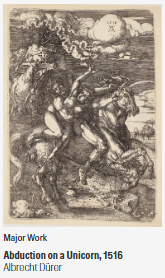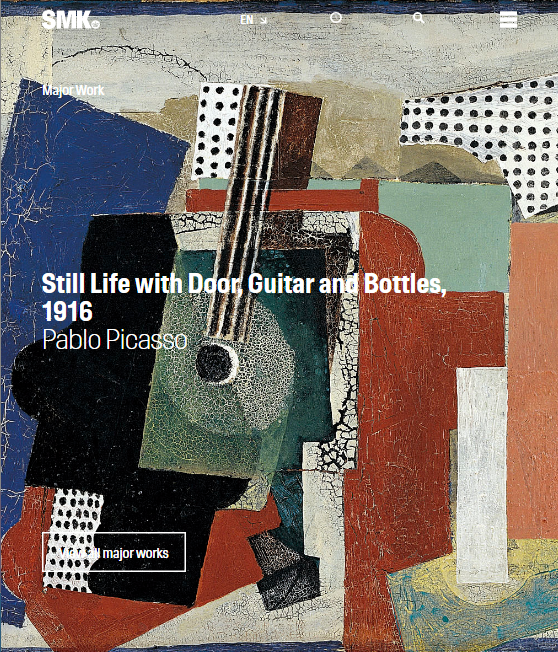The are museum is thoughtfully organized into distinct thematic sections, each highlighting a different era and style of art:
- 1300s-1800s European Art: This section features historical European works, including iconic pieces from various movements and periods.
- 1750-1900 Danish and Nordic Art: Here, you can explore works by Danish and other Nordic artists, reflecting the regional art evolution and unique perspectives.
- 1900-1930 French Art: This gallery showcases French masterpieces from the early 20th century, providing a glimpse into the artistic innovations and movements of the time.
- Post-1900 Danish and International Art: This contemporary section features Danish and global artists, capturing modern and post-modern expressions.
In addition to these themed galleries, the SMK also hosts various temporary exhibitions, adding a dynamic element to its offerings. The museum isn't just about viewing art; it’s also an interactive experience. There is a dedicated corner for still-life drawing, where visitors can try their hand at creating art. Inspired by the surroundings, I took the opportunity to draw a flower vase, adding a personal touch to my visit. Beyond Danish artists, the collection includes works by renowned European masters such as Rubens, Rembrandt, Munch, El Greco, and Matisse. This diversity makes SMK a comprehensive art destination, celebrating both historical and contemporary art across a wide spectrum.
The following is an excerpt from SMK's homepage.
Let's take a closer look at some representative works from this era. First, we have *“Portrait of Madame Matisse”* by Henri Matisse. This painting is a portrait of Matisse's wife, capturing the delicate emotions of Madame Matisse, possibly reflecting the joy she felt during their early married life. The inclusion of a woman as the subject of a portrait adds a significant touch to the artwork.
Next, *"The Abduction of the Unicorn"* is an engraving by Albrecht Dürer. This work is one of only six steel engravings by Dürer. Unlike other artists who used copper or zinc plates for engraving, Dürer experimented with steel plates. However, steel rusts easily, and during the process of transferring the engraving to paper, the rust left stains on the paper. Perhaps this led the perfectionist Dürer to revert to the more common materials like copper or wood for his engravings.

Moving on, we have a sculpture by Giovanni Lorenzo Bernini, one of the greatest sculptors of the Baroque era, who made a significant impact on the genre of busts at the young age of 20. The piece is titled *“Bust of Camilla Barbadori.”* Camilla Barbadori was the mother of Cardinal Maffeo Barberini, who later became Pope Urban VIII, Bernini's most important patron. The mastery of light and shadow in Baroque sculpture is evident in the smooth marble face of Camilla Barbadori, the deep shadows cast by her cloak, and the life-like gaze that Bernini achieved by carving around the eyes, creating a shaded effect that invites viewers to interpret the piece in their own way.
Another notable work is Andrea Mantegna's *"Christ as the Suffering Redeemer,"* which depicts a scene following a passage from the Gospel of Luke:
“On the first day of the week, very early in the morning, the women took the spices they had prepared and went to the tomb. And they found the stone rolled away from the tomb.”(Luke 24:1-2)
The women’s journey to Calvary is not directly referenced in the painting, but Mantegna merges two scenes: the risen Christ with five wounds and two angels, seemingly singing hymns and praising God.
Another significant piece is Peter Paul Rubens’ “The Judgment of Solomon.” This painting depicts the biblical story where King Solomon resolves a dispute between two women claiming to be the mother of a living child. Solomon orders the baby to be cut in half and shared between them. The true mother, horrified, gives up her claim, revealing herself to Solomon. The painting contrasts warm and cold tones; the true mother is dressed in warm yellow, while Solomon sits on a golden throne in a red cloak. The executioner, ready to divide the baby, is draped in blue, while the false mother wears a cold white dress.
Danish and Northern European Artworks from 1750 to 1900
Now, let's look at some works displayed in the Danish and Northern European exhibition rooms, starting with Edvard Munch's *"Evening Talk."* This painting expresses Munch's lifelong obsession with loneliness and his twisted view of romantic relationships. For the first time, Munch uses his unique language to depict human emotions, pain, and love more deeply than ever before.
In the summer of 1889, Munch settled in Åsgårdstrand, a village on the western shore of the Oslo Fjord. It was known for its Bohemian community. Here, he used theater critic Sigurd Bødtker and his sister Inger as models to stage a narrative about absence and loneliness. The painting seems to portray these two figures.
This work marks a departure from naturalism for Munch. Some areas are painted with lively brushstrokes that freely choose colors unrelated to the objects. The contrasting placement of sunny landscapes and shadowed figures creates a symbolic and dense atmosphere.
French Artworks from 1900 to 1930
Next, we move to *"Alice"* by Amedeo Modigliani, an Italian artist who moved to France. Modigliani is known for his portraits, and by the time he painted this piece, his unique rendering style was fully developed. The girl is depicted frontally, with a geometric structure that creates harmony and calmness.
*Edgar Degas’ “L'intime”* is characterized by a cold intensity that seems less interested in the body’s erotic aura than in observing it as an object. Degas’ depiction of women—whether aging prostitutes, weary laundresses, or unattractive dancers—carries traces of their professions. His choice of type and style reflects Degas' socio-cultural interpretation of women, projecting images of the societal structures they inhabit and the lives they lead.
However, Degas' misogyny also includes a sharp, undeniable erotic sensuality in his works. The masquerade-like feeling of the painting, its similarity to stage costumes, defines the woman in relation to the waiting man. The man’s gaze (cropped out of the photo) is fixed on her beyond the subtle gesture of his cane. The space itself becomes a framework for these socially and culturally imposed relationships, creating an image of a much-anticipated union.
Henri Matisse's *"Le Luxe II"* depicts three nude women bathing in a natural setting, drawing on the traditional image of the mythic Arcadia. There are two versions of this motif, the first of which is displayed at the Pompidou Center in Paris. Matisse revisited this theme in a new way, with *Le Luxe I* painted in oils using dry brushstrokes and *Le Luxe II* rendered in a uniform application of watercolor. He experimented with different techniques to express the same motif.

Pablo Picasso's still life, *"Door, Guitar, and Bottle,"* depicts a guitar, two bottles, and part of a room. Without the title, you might recognize the guitar, but the other objects would be harder to identify. Still lifes were a favored motif among Cubist artists like Picasso, who used them to create compositions that had no relation to actual reality. One of the groundbreaking techniques developed by Cubist artists was collage, where various types of paper were cut and pasted onto canvas. After 1913, Picasso and Georges Braque began painting pictures that imitated these collages.

Another captivating work is a painting by André Derain, whose distinct style often catches the eye, making his works popular in publications and posters. Derain's attention to composition, color, and line is meticulous, and in his piece *"Woman in a Chemise,"* the woman's hand, though not entirely distorted, has a freshness and wildness to it. The figure exudes a calm yet confident demeanor. The background is set in "The Dead Rat," a restaurant and nightclub, and the woman depicted is a dancer there. This piece is one of Derain's notable works from his Fauvist period, during which he collaborated with Henri Matisse. Together, they experimented with a new approach to coloring, using color as a tool to express emotional states.
Danish and Multinational Artworks Post-1900
Here, we encounter another work by Pablo Picasso, *"Naked Woman at a Window."* Picasso is often associated with his Cubist works, where faces are depicted from multiple angles and combined into a single image. This piece is a prime example of his style.
In this blog post, I’ve highlighted some well-known artists whose works could even be featured in high school art textbooks. If you’re interested in learning more, I recommend visiting the National Gallery of Denmark’s website for detailed descriptions of these and other artworks.
After finishing our visit to the National Gallery, we headed to Copenhagen Station. From there, we took the IC train bound for Lufthavn, and after just two stops, we arrived at Copenhagen Kastrup International Airport. As far as I know, there are no direct flights from Denmark to Incheon (though this may have changed), so we transferred in Doha, Qatar, via Qatar Airways.
We landed in Doha close to 11 PM local time, and I was shocked by the intense heat as we exited the plane and walked into the terminal. It felt like the air from a scorching furnace, something I had never experienced before, especially so close to midnight. The airport was filled with people dressed in traditional Arabian attire, reminiscent of what I’d seen in "Arabian Nights" animations. Since then, I haven’t had the chance to transit through any other Middle Eastern countries, so this remains my first and only time setting foot on Middle Eastern soil. Maybe it was just my imagination, but I could almost sense the ease and affluence of the people there, likely stemming from the region's oil wealth.
After browsing the duty-free shops, about three hours later, at 1:40 AM, we boarded our flight to Incheon. Since it was a red-eye flight, I barely remember eating the in-flight meal. To make matters worse, there was a crying baby on board who didn’t stop for a moment, making the flight an ordeal. If the baby’s mother had at least tried to soothe the child, I might have felt some sympathy, but the baby was practically neglected.
With this post, I’m concluding my series on our independent travels through Finland, Sweden, Norway, and Denmark. In the next post, I’ll share a general review of the trip, along with details on the budget and the hotels we stayed in.

댓글
댓글 쓰기